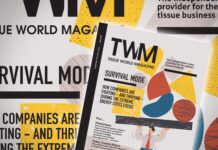
While it is placed at 54th place this year, in the Americas the country’s reputation as a gateway to the south and launch pad to the north is becoming cemented. The stereotype of a country ridden by drugs, cartels, kidnapping and violence is finally starting to fade.
The number of middle-class households has reached 3.2 million, the equivalent of 24.2% of all households. The poverty rate – defined by the World Bank as anyone living on less than $1.25 (81p) a day – has fallen from almost 50% to 34%.
Last year saw a drop in its economic performance, but it is widely expected to be just a blip. The peso’s value has dropped in some accounts of up to 30% and inflationary pressure has put up prices. Further up the supply and prices chain, energy costs for manufacturers have almost doubled, and rainfall and supply levels are dramatically low.
The good news for tissue is that loyalty established during the better times remains strong. Affluent consumers have stayed with good-quality tissue products.
While we may be slightly wary of the longevity of acronyms, given that the last major one should perhaps have been RIC rather than BRIC, given Brazil’s recent performance, it comes with little surprise that Colombia finds itself leading one. The CIVETS – Colombia, Indonesia, Vietnam, Egypt, Turkey and South Africa – are six key countries for the future global growth of the tissue market.
Our Country Report confirms the general optimism, and points to an encouraging future. There is significant unmet potential in retail consumer tissue, estimated to be in excess of 140,000 tonnes, representing a good platform for further category development and growth.
Plus, unlike much of the rest of the world, Colombians have not as yet come to the discovery of being unable to conduct life without the multi-use kitchen towel. Sales growth has slowed to a relatively low 4% from a low base, partly due to the traditional popularity of the trapo de cocina, or kitchen cloth.
Innovative manufacturers are on the case, developing a hybrid … a more durable kitchen towel that can be used several times. That’s the mood in Colombia these days.
A surprisingly good year
Global tissue consumption reached approximately 34.8 million tonnes in 2015, up more than 1.3 million tonnes on 2014. That means worldwide growth beat expectations at 4%.
A breakdown of the regions suggests widely fluctuating markets: steady in the US, Canada flat, decline in South America, Russia down, and Western Europe steady with tissue in troubled southern nations recovering quickly.
The big drivers have been China with growth better than forecast at 10.5%, Turkey at 14%, Africa’s new capacity in the north prompting consumption growth close to 6%, and Iran enjoying regional growth close to 10% … TWM’s next Country Report will come from Iran.
Full report in MarketIssues.

































